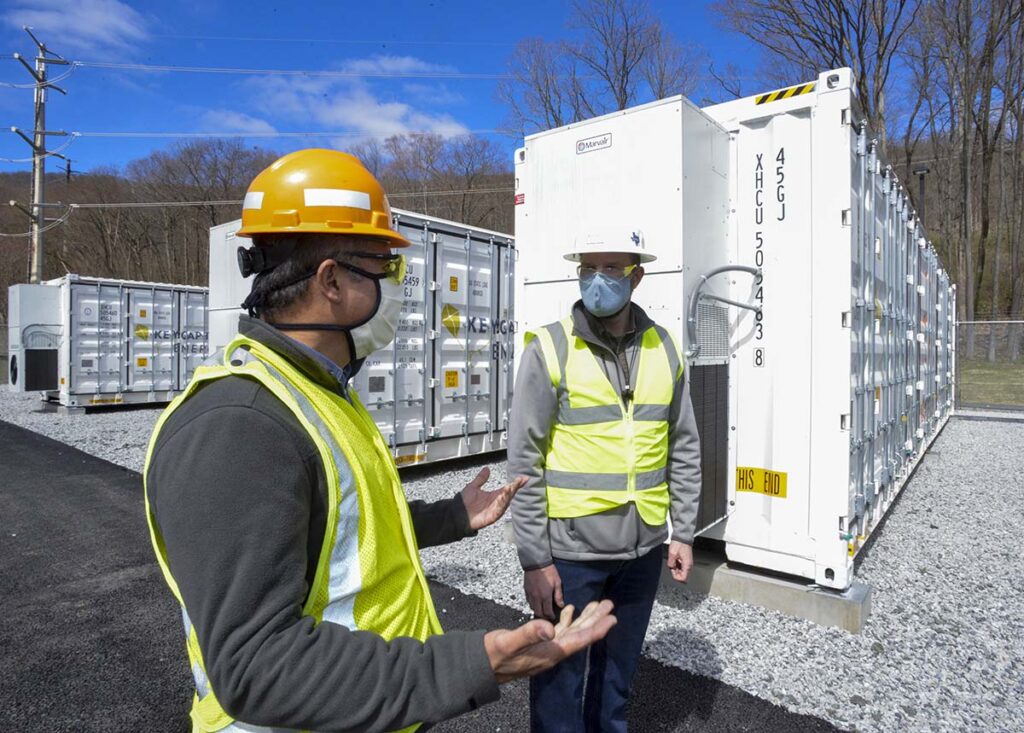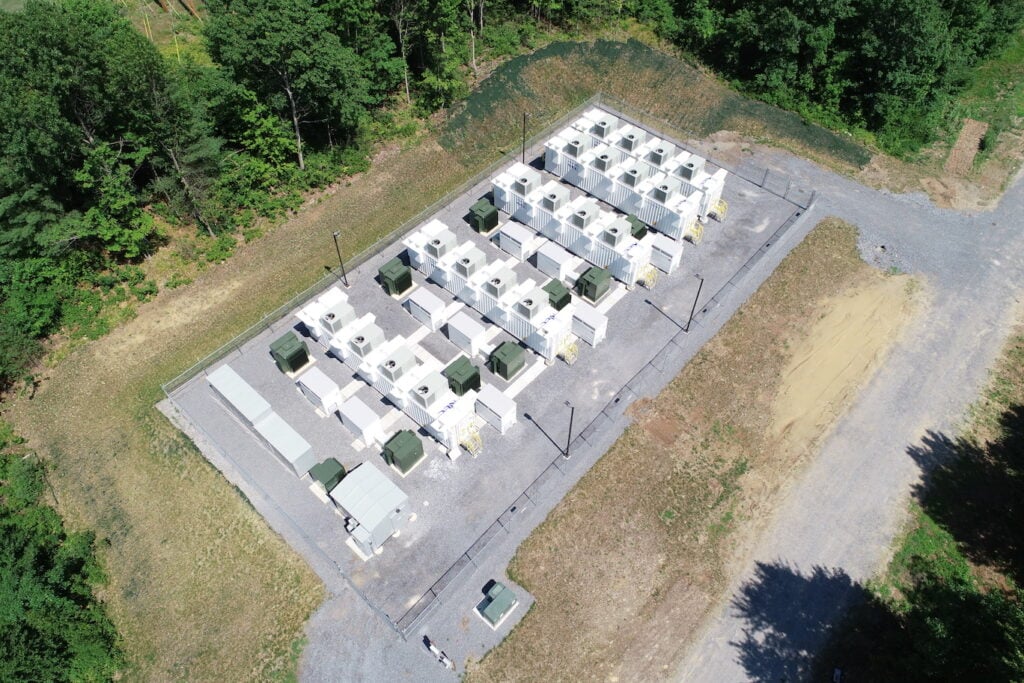
This is the second and final instalment of our interviews with grid-scale battery energy storage developers on the market for battery storage in New York, a state with high ambitions and tall challenges when it comes to clean energy.
New York consistently ranks among the top US states for energy storage according to consultancy and research groups like Wood Mackenzie Power & Renewables.
Enjoy 12 months of exclusive analysis
- Regular insight and analysis of the industry’s biggest developments
- In-depth interviews with the industry’s leading figures
- Annual digital subscription to the PV Tech Power journal
- Discounts on Solar Media’s portfolio of events, in-person and virtual
But the drop-off from the standout leaders like California or Texas down to New York is a big one. Texas is at around 2GW of large-scale deployments and California more than 4GW of cumulative installations, while New York has scraped together just over 110MW to date, albeit with more than a gigawatt of contracts in place.
New York’s high ranking is down largely to the ambitions of the state’s policymakers, who have set a deployment target of 6GW by 2030 and an interim 3GW by 2025 target, expected to comprise largely of what the state defines as ‘bulk’ storage assets of over 5MW each.
We hear directly from two leading developers of energy storage resources in the state, who explain what the industry can get excited about as the market develops – and what it should be wary of.
These interviews, with Kelly Sarber of Strategic Management Group, and Jeff Bishop of Key Capture Energy, were used in part for the recent feature article, ‘Hunting the ‘missing money’ in New York’s energy storage market’.
The article ran in our quarterly journal PV Tech Power (Vol.34), which you can subscribe to, to read in full, or read an exclusive extract of the article at Energy-Storage.news, here.
In today’s instalment, we speak with Jeff Bishop, CEO of Key Capture Energy. Key Capture Energy is headquartered in Albany, Upstate New York, and while it has developed and owns projects in various states – with a growing portfolio in Texas – the company holds its home state dear.
Key Capture Energy (KCE) actually delivered New York’s first-ever grid-scale battery storage project back in 2019, making it a genuine first mover. It continues to work on other projects in the state, with its latest, KCE NY 6, a 20MW/40MWh asset, expected to go online soon.
The company develops projects to own and operate, and Bishop says that he’s confident New York will have a robust energy storage market within the next couple of years, and says it’s probable the 6GW target will even be surpassed, such is the fundamental need for storage in New York’s energy system.
You can read yesterday’s published interview with Kelly Sarber, CEO of Strategic Management Group, here.
We’ve heard it has been quite challenging to get projects off the ground in the state, but can you briefly summarise Key Capture Energy’s view of the energy storage market in New York?
We’ve been developing in New York state since 2017. And we have a portfolio of about 1,000MW of projects that are under development there, including two projects that are currently in operation, KCE NY1 and KCE NY 3, we have one that is at the very end of construction now, KCE NY 6, over near Buffalo.
As for the rest of the state, the key question just has been how do you get the ‘missing money’? Where New York doesn’t have the volatility of a market like Texas and so hence, there’s not really the same value proposition there is down in Texas. But with New York, they have the goal through the Climate Leadership and Community Protection Act (CLCPA) of 100% zero-emissions generation by 2040.
So as we look at everything that New York is doing: from distributed solar to massive amounts of offshore wind, to trying to retire all the New York City and Long Island fossil fuel plants, to increasing amounts of wind, utility-scale solar, storage is desperately needed.
And so there was a original goal back in 2018, 2019, for 3,000MW by 2030. Governor Hochul, she doubled it to 6,000MW by 2030. Just recently, NYSERDA, along with the Public Service Commission, came out with a proposal on how the market would be structured for battery storage projects.
We really think that after this goes through all of the regulatory processes, and once they start issuing RFPs, that this will be a way that we’re going to be seeing storage really taking off in New York State by 2025.
That implementation plan from NYSERDA and the New York Public Service Commission (PSC), Energy Storage Roadmap 2.0, includes proposals for new incentive schemes to support large-scale energy storage, which would be tendered for. Key Capture Energy was one of the few available to avail of the Market Bridge Acceleration Bridge Incentive scheme that was previously in place. Which of your projects got that?
KCE NY 1 and KCE NY 6 both received a Market Acceleration Bridge Incentive (MABI). Those were [state] grants in order to be able to start demonstration projects, and then KCE NY 3 is a 4.4 megawatt project that was won in a non-wires alternatives RFP for one of the New York utilities (Orange & Rockland).
The MABI, this original pot of US$150 million, New York State hasn’t seen the full take-up of those projects in the way that everybody was expecting, and that’s because the cost of construction went up dramatically in the past year and a half.
We are expecting, [assuming getting regulatory approval for the tenders take most of 2023], New York will probably do a 1,000MW solicitation in 2024, followed by another 1,000MW in 2025, and another 1,000MW in 2026 for the Index Storage Credit.
Functionally, it acts like a Contract for Difference (CfD), and it both incentivises battery storage owners to have really good software that can be able to optimise revenues, in a way that the New York grid needs them, while also giving a financial backstop to be able to get financing for these projects.

Is there anything you can share with us, in terms of lessons learned about how to operate and optimise battery storage in New York from the first couple of years of operation of the 20MW KCE NY 1 project?
We’ve invested very heavily, internally and on systems to really be able to have great algorithms that can allow batteries to participate in day ahead, real time market bid-in based on machine learning and artificial intelligence (AI).
We always have to start with small projects, in order to learn, be able to get our software working correctly for revenue optimisation, and then we can scale. We did that in Texas, with 10MW projects, we’re now building 100MW projects.
In a similar way, in New York, KCE NY 6, it’s a two-hour battery system. We’re probably going to be doing a fair number of two-hour systems in New York. So, we really needed to get that one online this year, so that way, whenever we build 150MW projects in the upcoming years, that we already have the software that’s ready to go. For us, that’s been the approach, and that’s been a learning and anytime you make assumptions on how batteries can actually bid in the market, they behave slightly differently, the rules are slightly different, the software is slightly different, so that really is key.
We’ve heard from Dr William Acker, executive director of trade group NY-BEST, that the new scheme for solicitations, the Index Storage Credit, has really come after extensive consideration of why the MABI scheme had slow uptake and that NYSERDA and PSC have tried to design a scheme that will work better.
Ever since I started the company in 2016, I’ve always been trying to figure out when talking with legislators with regulators, what is the storage [equivalent to] the Renewable Energy Credit (REC)?
The renewable portfolio standards are pretty well defined, where you have 1MWh of carbon-free electricity, that equates to one renewable energy credit (REC). It’s fungible, you can trade on it, you can contract on it. It’s really easy.
With storage, it’s always the question of: what are you procuring? And California has been able to do it through their resource adequacy programme. Other states haven’t quite followed that, where it’s procuring the capacity.
So instead here [in New York] we are excited by the Index Storage Credit, and there’s been a lot of interest from regulators on it, because everyone, every state, is trying to figure out exactly how to procure. We think that this might be the start of a trend.
Some of the other challenges for energy storage in New York that we’ve heard about include long queues for grid connections, and lack of availability of suitable land. Meanwhile there are other challenges to the industry today that aren’t particular to New York, such as supply chain and procurement. If the market is to take off from around 2025 as you predict, could any of those – or other factors – pose challenges to getting New York to 6GW by 2030?
My macro view is: good projects will always get built. It’s just a question of timing.
When I started a wind energy company in Houston in 2006, we had been developing a project in Wisconsin since 2003. Kept bidding it out, kept bidding it out, had to extend lease terms multiple times. And I believe in 2018, the project finally got built.
It’s going to be something similar here, where for the projects that are in really key pockets, where energy storage can provide most value, interconnection may take longer, permitting may take longer.
All the normal things, whether it’s extreme delays on main power transformers, whether it’s waiting for the battery storage manufacturing industry to scale, there are headwinds, but ultimately the good projects will be built. As we’re looking at New York, with all of their climate goals, 6,000MW is going to be the minimum of storage, quite frankly, where they’re going to be needing longer duration storage coming up, they’re probably going to be needing some clean hydrogen. They’re going to be needing a lot more than just 6,000MW.
[In New York] we regularly bid in with both onshore wind, utility-scale solar, as well as offshore wind, and it’s always just a question of when one of those projects will hit.
The state needs it all, and then the energy storage Roadmap 2.0, I believe they’re trying to get a third of energy storage into Upstate. So it’s going to be needed everywhere. Energy storage projects definitely help optimise the existing transmission system. The new transmission systems coming in are also going to be providing all sorts of benefits. Overall, it’s definitely ‘all of the above’, as far as where we’re going to be seeing storage, and where we’re going to be seeing new generation.

